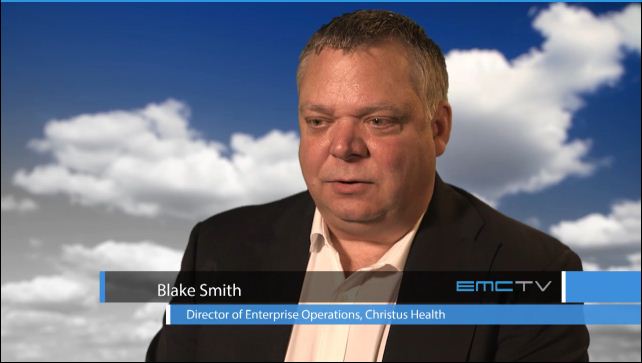CHRISTUS Health is an international Catholic not-for-profit health system. We provide hundreds of services in over 230 hospitals, long-term care facilities, clinics, outpatient centers and health ministries and ventures located primarily in the U.S. We’ve got 30,000 associates and around 10,000 doctors. CHRISTUS Health is listed among the top ten Catholic health systems in the U.S. We support 8,000 concurrent users every day across our servers, accessing our Tier 1 Electronic Medical Record app, Oracle, SQL Server and other apps—no small operation.
Our infrastructure goal is 100% virtualization, operating completely within a private cloud. Four years ago we were about 30% virtual; today we’re 83% there. We’ll seamlessly deploy and manage new solutions, and continually move the load to where users will experience best performance. An enormous amount of infrastructure transformation has been involved from the start and EMC has been a part of it almost from day one.
The first thing we had to do was consolidate. We like to say we went on “The IT Diet;” since the beginning, we’ve shed 100,000 pounds of servers. We went from 3300 physical servers to 400. We moved to remote data centers, a primary and a backup data center and a cold site. When we’re fully virtualized and in the private cloud, we’ll have even fewer data centers, all hot sites. At part of this consolidation, we used EMC to dramatically reduce our storage footprint. We implemented VNX unified storage platforms and immediately eliminated nearly seven storage frames—nearly 50% of total frames—while running VMware, SQL and Oracle. We put VMAX 20K enterprise storage arrays in our primary backup data center, and reduced our frames from four to two.
We’ve already deployed a data mobility and continuous availability solution between our primary and backup data centers. To support this we use EMC’s VPLEX technology, which will ultimately allow us to deliver simultaneous, active-active information access within, between and across these private cloud infrastructures. VPLEX technology is a big part of our business continuity and disaster recovery strategy. Many of our facilities are in hurricane zones and when systems go down we have to be able to bring them up instantly. VPLEX continuous availability solution makes that very easy to do.
We must also be prepared for human error: one that corrupts or destroys data. Here, we use EMC RecoverPoint software. To validate it in a testing environment, we overwrote some of our EMR data, and using RecoverPoint software , were able to recover the system right up to five minutes before the event, with zero loss of data.
This shows how fully committed we are to our goal of 100% virtualization and IT transformation: our EMC solutions also include Data Domain, Isilon, Avamar, FAST VP, FAST Cache and Networker technology. EMC returns that commitment. They’ve always been there when we hit complex problems, and we do not know where else to turn. From the beginning, they’ve brought resources to bear that I don’t think would normally be available to a company our size.
